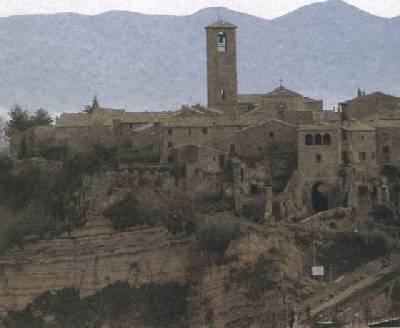Bagnoregio
is the chief town of a territory extending for 7,500
hectares over the eastern slopes of the volcanic hills of
Bolsena. Its altitude decreases from the summit of Mount
Monterado (630 metres above sea level) to the wide valley
surrounding Civita (150 metres above sea level). This
altimetry range has caused the territory to feature a
changing vegetation and a wide variety of stones such as
the trachytic tufa of Monterado or the clay layers of
Civita.
The territory includes five small towns: Vetriolo, Castel
Cellesi, Civita, Capraccia e Ponzano.
Bagnoregio is one of the most characteristic centres in
Upper Lazio and it is the hometown of the famous seraphic
scholar St Bonaventura (1217-1274).
The first human settlings date back to the Pre-Etruscan
Age. The town had hosted the Episcopal See since 60 A.D.
and it was successively destroyed by the Goths and the
Longobards. Earthquakes hit Bagnoregio for centuries, the
severest of all being that of 11 June 1695.
Bagnoregio is situated mid-way between Viterbo and
Orvieto, they all have in fact historical, archaeological,
geographical and social similarities. The roots of this
sort of kinship dates back to medieval times when the
three towns were politically linked.
Don't forget to visit:
The Ossuary-Pyramid (Piramide-Ossario). It was
built in 1891 to honour the Garibaldians who were killed
in the battles of September-October 1867. It stands in the
Rimembranza Park and reminds of Caio Cestio's Pyramid in
Rome. It is 12 metres high and it has a 10 metre
triangular base.
The Albana Gate (Porta
Albana). It is sited in Trento e Trieste Square.
Originally, it stood about 15 metres back and it was
actually the city's front gate. The Albana was arguably
built by Orvieto architect Ippolito Scalza.
Saint Bonaventura's
Temple (Il tempio di San Bonaventura). It stands high
by the right side of the Albana Gate. The Greek
cross-shaped building is a work by architect Pietro
Gagliardi.Belvedere.
This place stands to remind of the old site of the
Franciscan monastery, unfortunately destroyed by
landslides and quakes. To the east of the hill is the
famous St. Bonaventura's cave dug out of tufa rock. Here,
according to local folklore, the Saint recovered from a
serious illness by St. Francis of Assisi's intercession.
From this beautifully scenic spot the town of Civita (the
"dying town") with its so-called "ravine
valley" can also be admired. |
 |
| The
Cathedral (La cattedrale). It stands on the site
of a church arguably built in 440 and dedicated to
The Madonna della Neve (The Madonna of the Snow).
The church was renovated in 1606 and it was
dedicated to St. Nicholas. It underwent numerous
modifications, the latest being that of 1779. It
preserves precious objects such as a 12th century
miniated Bible (probably owned by St. Bonaventura)
and a painting by Vanni, featuring Mary Magdalene.
There is also a silver reliquary in the shape of an
arm imparting a blessing, which contains St
Bonaventura's arm-bone.
St. Bonaventura's
Monument (monumento a San Bonaventura). It was
erected in Piazza S. Agostino and unveiled on 13
July 1897. It has a base made of Baveno granite on
which stands the bronze statue of the Saint. The
work is by the Neo-Classical sculptor Cesare Aureli.
The Annunziata
Church (La chiesa dell'Annunciata). This
Romanesque-Gothic work is sited in Piazza San
Agostino and features remarkable paintings by Taddeo
Di Bartolo and Giovanni di Paolo. The 1524 cloister
by Michele Sanmicheli and the 1604 monumental well
by Ippolito Scalza are also worth a visit.
Civita di
Bagnoregio. Situated on a tufa crag sitting on a
clay layer, this historical town is hopelessly
eroded by water and slowly crumbling by the sides.
For this reason the writer Bonaventura Tecchi, born
in Bagnoregio, gave it the name of "the dying
one". Civita is connected to Mercatello
location through a 300 metre long bridge made of
reinforced concrete. It has an incredible church,
probably erected on the remains of a pagan temple,
which preserves a uniquely beautiful Flemish
crucifix. The "Ponticelli", that is, huge
vertical ridges of clay resulting from a long
process of erosion started thousands of years ago
and which is still active, offer a breath-taking
view from the town walls.
|
|
The
Naturalistic Patrimony. What strikes the visitor most
is certainly the incredible expanse of Bagnoregio wooded
hills. LocalitÓ Carbonara is a very good example of the
evocativeness and charm of Bagnoregio's forests which,
unfortunately, have considerably lessened year after year.
Here grow the tallest and most incredible oak trees in the
area. Nearby, the tourist resort of Campolungo, in LocalitÓ
Monterado, offers scenic walks from which one gets a
splendid view of the Lake of Bolsena.
Production. Corn is
Bagnoregio's main produce. The manufacturing sector and
handicraft industry are equally relevant, ranging from the
extraction of nephritis (an important type of basalt) to
obtain building materials, to thermoplastic production;
from olive oil and cheese industry to stone, iron, wood
and pottery manufacturing.
|

